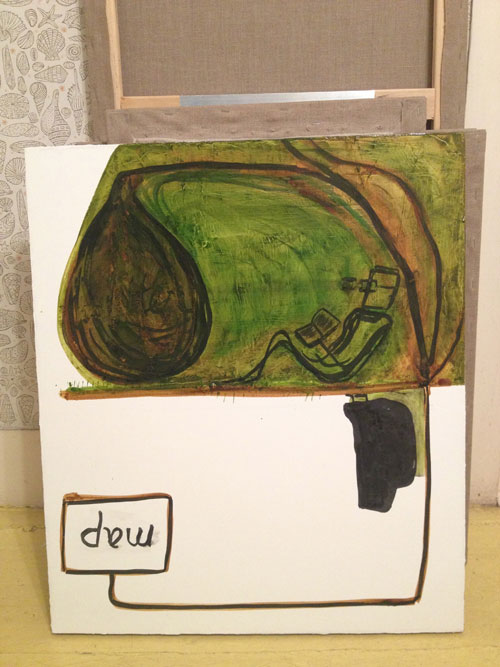Earlier this summer, I sketched this imperative for my work:
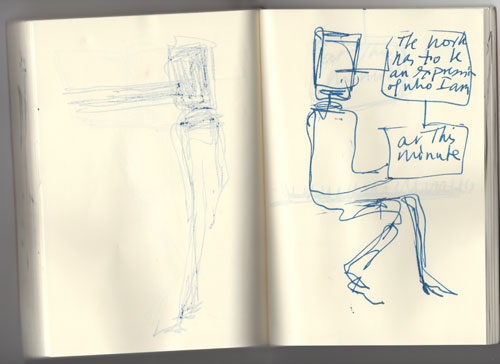
A page or two later, I did a bit of copy-editing:

For some reason there seemed to be an important difference between at this minute, and right this minute, with right this minute seeming more idiomatic and more like an order than a temporal indicator. But whether at or right, having written /sketched this out only makes it ever more apparent just how hard it is to do, how seldom work arrives in and of the moment, this minute and not the last or the next.
Every artist works within a number of contexts and territories, so that “this minute” is also the cultural moment, a network of discourses, histories, and ideologies that are always at stake, and even when an artist is not directly engaged in appropriation and sampling, much work done today has an appropriative dimension, even contemporary abstract expressionism comes out of an appropriative mindset and even historical abstract expressionism was always a negotiated ballet between the canvas as an arena for action and actions that were considered, deliberately explored.
Every work of mine is at the very least related to all the ones that came before, particularly within a time frame or series, and simple methods of mechanical reproduction such as stencils and tracing are part of the process. I scan quick notebook sketches like the one above and have printouts scattered around my studio as references, including the pages reproduced above, so “right this minute” is relative.
A case in point: today’s post is about work done on July 25, yesterday’s date. In all, a figure is off of the vertical, either asleep, floating, adrift, or forcibly expropriated from a space of relative safety.
July 25, 1979
Another in the series of Figures I did in 1979, in which abstracted figures, somewhat like buildings and sails, were often in a kind of classical stasis. I don’t remember what I was thinking when I did these, though I think they were indirectly about my entry in to the New York art world as an adult.
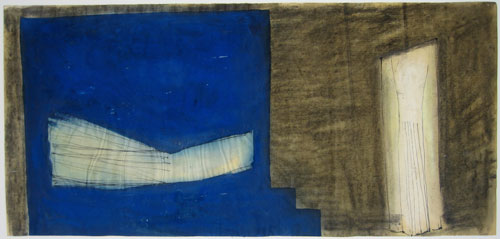
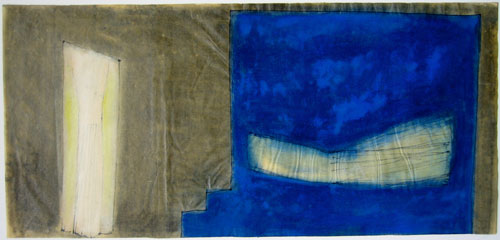
July 25, 1984
Another in the series of large gouaches on rice paper done in 1984, this was a very meticulously detailed painting of seaweed attached to the basic figurative shape I was working with at the time, shifting gently in the bay at low tide.
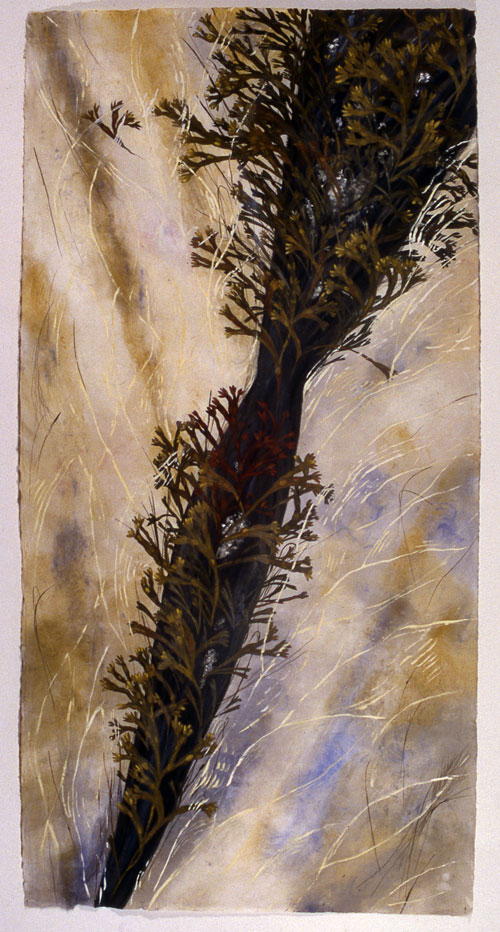
Mira Schor, Drift, July 25, 1984. Gouache, dry pigment, medium on rice paper. 72 x 36 in.
July 25, 2012
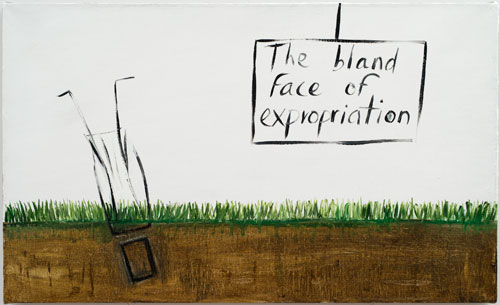
Mira Schor, The Bland Face of Expropriation, July 25, 2012. Oil on linen, 18 x 30 in.
This painting, The Bland Face of Expropriation, done July 25, 2012, is based on this drawing done July 22, 2012:
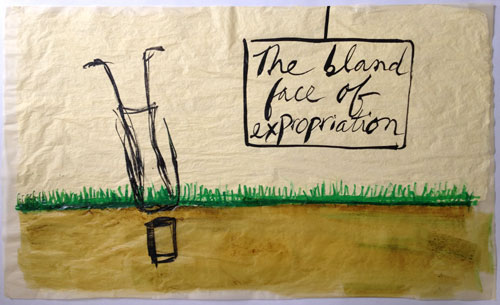
Mira Schor, The Bland Face of Expropriation, July 22, 2012. Ink and gesso on tracing paper, c. 18 x 30 in.
Right this minute a year ago, I was furious about something. Fury can be energizing. The conduit between internalized corrosion by fury at injustice within to artwork that felt connected to much larger forces than the individual, was the book I was reading at the time, Silvia Federici‘s brilliant Caliban and the Witch: Women, The Body and Primitive Accumulation:
The book evolved from studies of “the history of capitalism and class struggle from a feminist viewpoint,” begun by Federici and others in the early 1970s. Federici examines the transition from late feudalism to early capitalism and the regime of “primitive accumulation.” It’s hard to do justice to the book without quoting the whole thing, but it’s a gripping, vivid tale, about how the tradition of the commons and other folk experience-based crafts and practices that had developed in the medieval period were forcibly, often violently eliminated and suppressed as part of the development of early capitalism which necessitated the expropriation of peasants from commons lands, and the violent expropriation of women from any role of equal participation in production of their own culture, in order to make them available to the devalued task of reproductive labor of the proletariat. She introduces her premise for the book as follows:
I. The expropriation of European workers from their means of subsistence, and the enslavement of Native Americans and Africans to the mines and plantations of the “New World,” were not the only means by which a world proletariat was formed and “accumulated.”
II. This process required the transformation of the body into a work-machine, and the subjugation of women to the reproduction of the work-force. Most of all, it required the destruction of the power of women which, in Europe as in America, was achieved through the extermination of the “witches.”
III. Primitive accumulation, then, was not simply an accumulation and concentration of exploitable workers and capital. It was also an accumulation of differences and divisions within the working class, whereby hierarchies built upon gender, as well as “race” and age, became constitutive of class rule and the formation of the modern proletariat.
Caliban and the Witch was one of a number of books I sought out last summer, to help me understand the socio-economic situation we’re in, of austerity, income inequality, and the death of the social contract that existed at least as an ideal up until the end of the 1970s. I also read Maria Mies’s Patriarchy & Accumulation on a World Scale, and Zygmunt Bauman’s Liquid Modernity but Caliban was the most interesting and also the most current, because I read Federici’s examination of the systematic “war on women” over three centuries to control female power against the background of last summer’s vivid demonstrations of the current war on women–last summer, if you recall, being the summer of “legitimate rape” and other appalling instances of misogyny and magical thinking about female anatomy.
Federici’s description of some medieval agricultural practices first made me look at the grass upon which my little avatar of self figure lay as the borderline between life above ground and the earth below as a generative field, so I placed my figure in the earth below the grass as a line of demarcation. But reading about the horrific suppression of women particularly during the period of the Witch-hunts (not as long ago as you may think–not some dark long ago of the “Middle Ages,” but from the mid-15th century through the sixteenth and seventeenth centuries), my recent personal experience of expropriation clicked with a larger history and around the word expropriation, and I plunged my avatar into the earth, head first, not of her own volition, Expropriation surrounds us, whether it’s corporate downsizing, unemployment, climate-caused displacement, or expropriation of bodies of knowledge that are deemed obsolete but these days the methods of expropriation are usually as violent as burning at the stake, they come with a happy face.
July 25, 2013
This year the process of expropriation seems to be in a kind of stasis or impasse, of topsy-turvy which remains unresolved or, simply, dual. In the studio yesterday, the 25th, “this minute” as of yesterday, below or above, depending on how you hang the painting, an Arcadian mid-summer moment in which time and matter slow enough to be studied at leisure, and above or below depending how you hang the painting, another avatar of self, shrouded to near invisibility for self-protection, in a temporary and barren shelter, with only the guidance of a map, which offers no directional guidance, simply the idea of a map or of mapping, right this minute:
